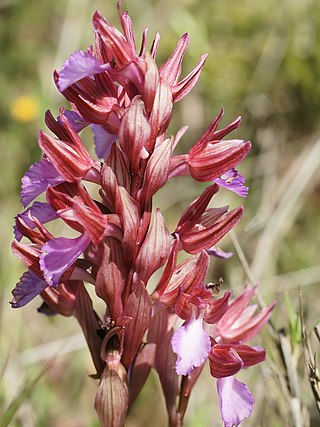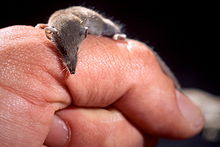
Anacamptis pyramidalis, the pyramidal orchid, is a perennial herbaceous plant belonging to the genus Anacamptis of the family Orchidaceae. The scientific name Anacamptis derives from Greek ανακάμτειν 'anakamptein' meaning 'bend forward', while the Latin name pyramidalis refers to the pyramidal form of the inflorescence.

Anacamptis is a genus of flowering plants in the orchid family (Orchidaceae); it is often abbreviated as Ant in horticulture. This genus was established by Louis Claude Richard in 1817; the type species is the pyramidal orchid and it nowadays contains about one-third of the species placed in the "wastebin genus" Orchis before this was split up at the end of the 20th century, among them many that are of hybrid origin. The genus' scientific name is derived from the Greek word anakamptein, meaning "to bend backwards".

Anacamptis morio, the green-winged orchid or green-veined orchid, is a flowering plant of the orchid family, Orchidaceae. It usually has purple flowers, and is found in Europe and the Middle East.

Orchis is a genus in the orchid family (Orchidaceae), occurring mainly in Europe and Northwest Africa, and ranging as far as Tibet, Mongolia, and Xinjiang. The name is from the Ancient Greek ὄρχις orchis, meaning "testicle", from the appearance of the paired subterranean tuberoids.
The Habitats Directive is a directive adopted by the European Community in 1992 as a response to the Berne Convention. The European Community was reformed as the European Union the following year, but the directive is still recognised.
The Perch is a 72.1 hectare biological Site of Special Scientific Interest close to Cheddar Gorge in the Mendip Hills, Somerset, England. It received SSSI notification in 1990.
Under South Korean law, the hunting and capturing of a large number of species of wild animals is prohibited. These include 64 species of mammals, 396 species of birds, 16 species of reptiles, and 10 species of amphibians. Most of these species are not actually endangered species, but are protected for other reasons. No freshwater fish are included on the list, although some are endangered.

Palmaria is an Italian island situated in the Ligurian Sea, at the westernmost end of the Gulf of La Spezia. With an area of 1.6 square kilometres (0.6 sq mi), it is the largest island of an archipelago of three closely spaced islands jutting from the mainland at Portovenere. The outer islands, Tino and the tiny Tinetto, lie further south.

Anacamptis papilionacea is a species of flowering plant in the orchid family Orchidaceae. It is commonly known as the pink butterfly orchid.

The fauna of Italy comprises all the animal species inhabiting the territory of the Italian Republic and its surrounding waters. Italy has one of the highest levels of faunal biodiversity in Europe, with over 57,000 species recorded, representing more than a third of all European fauna. This is due to various factors. The Italian peninsula is in the centre of the Mediterranean Sea, forming a corridor between central Europe and North Africa, and it has 8,000 km (5,000 mi) of coastline. Italy also receives species from the Balkans, Eurasia, and the Middle East. Italy's varied geological structure, including the Alps and the Apennines, Central Italian woodlands, and Southern Italian Garigue and Maquis shrubland, also contribute to high climate and habitat diversity.

The Nera Gorge-Beușnița National Park is a protected area situated in Romania, in Caraș-Severin County.

The Kazantyp Nature Reserve is a small reserve in the Lenine Raion on the Kerch Peninsula in Crimea. The reserve includes both territory of Cape Kazantyp and coast-aquatic-complex.

Mount Profitis Ilias is a 798-metre-high (2,618 ft) mountain on the Greek island of Rhodes. It is named for the biblical Elijah.

Orchideae is a tribe of orchids in the subfamily Orchidoideae. Historically, it was divided into 2 subtribes, Orchidinae and Habenariinae. The subtribe Orchidinae alone contains about 1,800 species. However, although some phylogenetic studies have established the monophyly of the subtribes, the generic boundaries are unclear, with many genera as traditionally circumscribed being paraphyletic or even polyphyletic. Species of genera such as Habenaria and Platanthera have been placed into both subtribes. A 2017 molecular phylogenetic study found that both subtribes did form clades, but did not formally recognize Habenariinae, because of missing genera and uncertainty over generic boundaries. The Asian species of Orchideae, in particular, have been subject to repeated changes of generic placement from 2012 onwards.

Ophrys speculum, the mirror orchid, is a species of Ophrys distributed throughout the Mediterranean that is pollinated exclusively by a single species of scoliid wasp.

Korission Lagoon is a coastal lagoon located in the southern part of the Greek island of Corfu, in the Ionian Sea. It is located near the village of Agios Mattheos and is separated from the sea by Chalikouna Beach. It has a surface area of 427 ha and it drains into the sea through a channel which bisects Chalikouna Beach. The lagoon was created by the sand dunes that cut the lake's basin off from the sea between 140,000 and 250,000 years ago.
Erich Nelson was a German artist, scientific illustrator, and botanist. He became well-known for his precise and aesthetic aquarelles and illustrations of European orchids, which total more than 2,000. His botanical and mycological author citation is: „E.Nelson“.

Ophrys holosericea, the late spider orchid, is a species of flowering plant in the family Orchidaceae, native to western and central Europe and the Mediterranean region. There has been considerable confusion about the identity of this species and the correct spelling of its name.


































